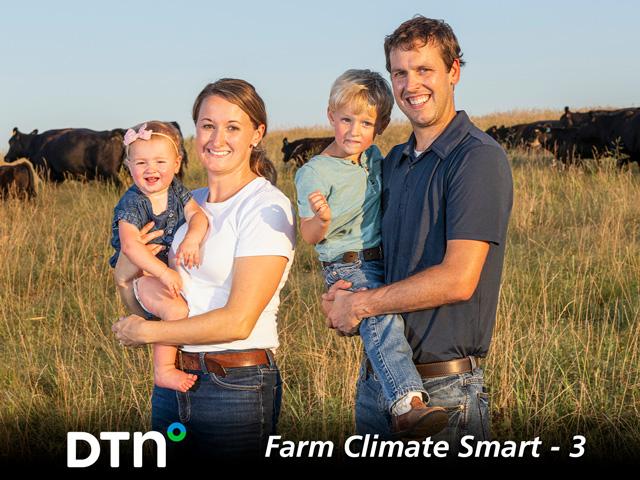Farm Climate Smart - 3
Weather-Ready Farms: Farmers Participate in Sustainability Pilot Program
Three-year-old Brooks Bohling gleefully chases his father, Trenton, around their family farm in Johnson, Nebraska, with not a care in the world. Brooks is often seen pedaling a red tricycle with all his might, while his 1-year-old sister, Karsyn, follows the leader as best she can.
Trenton and Ashton Bohling say their two toddlers are the reason they need their farm to be sustainable and safe for the long term.
The way they see it, making the farm weather-ready and safe go hand in hand with planning for the future. That's why the Bohlings opted to take part in the University of Nebraska Extension's Weather Ready Farms program as one of eight pilot farms.
Weather-ready farm is more than a catch phrase to describe myriad ways producers can prepare for abruptly changing and severe weather.
"I think it's important to remember the context of time and to realize that we're a small piece of the puzzle; but with any puzzle, it only takes a small piece to be noticeable," Trenton Bohling says.
"I don't necessarily believe climate change is a new phenomenon, although the reasons for it may be different in each decade, century or millennia. The climate and weather will always be changing and will always keep us guessing. With change being the only constant, isn't it our duty to prepare our families, our farms and our future for whatever it is to come? The realization that things will forever be fluctuating should be all the reason we need to implement long-term plans. I feel it's our duty to our families, communities and country to do all we can to become less dependent on things we cannot control."
DTN/Progressive Farmer is continuing its special series of articles called Farm Climate Smart that examine what the term means, looks at current and future economic opportunities the movement offers for farmers and ranchers, and highlights what some producers are doing now to make their land and crops more resilient to a changing climate. Today's article, the third in the series, looks closer at a pilot program that helps growers enhance sustainability and safety efforts on their operations now and for future generations.
PROGRAM DETAILS
Farmers in the two-year program learn about conservation, natural resource management, improving soil health, disaster preparedness, farm financial management and climate-smart agriculture -- but there are no limits as to how farmers can make improvements to their farms.
The program includes an on-site evaluation of each operation by Nebraska Extension, seeking out what farms do well and what might be improved. (Visit https://weather-ready.unl.edu/… for more information.)
Producers are offered educational events through Nebraska Extension and other resources and are required to log 40 hours of education through Extension. Each farm must work on a specific project, anything from installing farm maps to weather stations to learning CPR.
Once farmers have completed the program, they undertake a verification process to gain the Weather Ready Farm designation. Farmers receive $1,300 toward their projects and about $1,200 in stipends for the work they do in the program.
The term "weather ready" means different things to every farm. But concerns boil down to a number of issues: How can producers make do with fewer inputs and rainfall? What can farmers do now to help the farm survive severe storms, floods, colder winters, more prolonged heat in the summer and drought? How can they make farms safe for the unexpected?
NEW WATERING SYSTEM
As part of their weather-ready program, the Bohlings are installing an energy-free water system that uses a 10-foot black tube installed in the ground. It uses ground heat to keep water free of ice for livestock.
Maintaining an available water supply for livestock is increasingly important in preparing for potentially farm-debilitating and animal-threatening weather.
"We won't have to worry about running hoses across our yard, making sure we're filling them up, making sure we're shutting off the water," Trenton Bohling says.
"It seemed kind of silly at first, but the more you think about things like, 'OK, if the electricity goes out in the middle of winter, what happens?'" he continues. "Some of the webinars and education we've been on really makes you think about what if, and that's more at the front of your mind after the last couple years of supply chain issues."
The Bohlings usually run 70 pair of seedstock Angus-based cows and sell a few bulls and bred cows and heifers annually to repeat customers. They recently have been breeding for more of a grass-based genetics program and crossbreeding with breeds like Fleckvieh for grass efficiency, as well as Wagyu for heifer calving ease and meat quality of the finished calves.
P[L1] D[0x0] M[300x250] OOP[F] ADUNIT[] T[]
In addition, the farm row-crops around 200 acres, diversified with corn/soybean/wheat/cover-crop rotations that allow livestock feed and integration, as well as a few acres of pumpkins.
Trenton Bohling says his operation strives for "very high" profit per acre on a smaller scale by utilizing efficient cattle, lower overhead inputs and resilient/regenerative cropping and livestock systems.
The Bohlings also rotationally graze cows, moving them every week to 10 days. "If time allows, I try to move them every day or every two to three days," he says.
SUSTAINED RELATIONSHIPS
University of Nebraska Extension agent and program director Nathan Mueller says the program is designed to create "sustained relationships" with other farmers and Extension educators by identifying educational opportunities and areas of expertise outside the program that could help farmers.
"It's a way for us to continue to make sure they're aware of all of our programs and then get credit for it somehow," Mueller says.
"But part of the idea was also to acknowledge the time that producers were willing to put in a group like this with acknowledgement in their community. So, the goal when they get through this (program) is they'll get a sign (to display on their farm). Part of farming is rural sociology."
Mueller says Weather Ready Farms is an individualized program designed to "meet producers" where they are in their operations.
Not only would Mueller like to see the program grow and expand in Nebraska, but also on a national level. He's working with Extension educators in other states, including at Purdue University, to launch similar programs.
He also wants to find ways for producers to get credit for the work they do to make their farms more sustainable. That includes efforts to have the program acknowledged by USDA.
"I've seen a change in attitude, in terms of weather, changing climate," Mueller says, "knowing that what they're doing now, they need to make some adjustments."
Producers do a number of things, he explains, that may be worthy of a reduction in crop-insurance premiums, for example.
What if insurance companies were to credit farmers for installing backup generators, creating windbreaks, installing terraces, improved irrigation scheduling?
"I think that's something our team would like to see long term, that this designation provides more financial benefits to the producers than it does now," Mueller points out.
Trenton Bohling says the weather-ready program has helped the family take stock in what its farm is already doing. "First of all, my parents were doing cover crops back in the '70s and '80s," he says.
"They didn't necessarily call it cover crops. It was feed for the dairy cows," he continues. "There was always a continuous run in the soil, always something growing. So, we do a lot of that stuff already that they were introducing but maybe some nitrogen management."
ATTENTION ON WATER USE
Bismarck Township, Nebraska, corn and soybean farmer Travis Runge has used the Weather Ready Farms program to sharpen his attention to water usage on his farm. He installed a weather station to improve irrigation efficiency on his 150-acre operation.
"It saves me from driving clear over here to look at a rain gauge," he says. "If it's raining or not, then I know I don't have to physically be here all the time."
Runge wants to strike a better balance by tracking rainfall and other weather events more closely before turning on the pivots.
He had a tract of land enrolled in the Natural Resources Conservation Service Conservation Stewardship Program for a time, during which he learned his irrigation system was just 83% efficient.
Like many farmers, Runge has an off-farm job and wants to monitor his crops as closely as possible.
What's more, installing a weather station allows him to also view data coming from other nearby stations, which, in turn, is helpful in making other cropping decisions.
Prior to installing a weather station, Runge says it was a challenge deciding whether to run pivots depending on wind speeds. "I look at my weather station like, 'Ooh, it is a 15-mile-an-hour wind, maybe I should wait until it calms down a little bit'," he explains.
He leases the ground he farms and gives the landowner access to the weather station. Other area farmers also are benefiting from his efforts.
"I have a farmer friend over by St. Edward, and his farms are 50 miles apart. He has no weather station, and he calls me all the time. He's like, 'I spent half a day driving around checking my fields.'"
For farmers such as Trenton Bohling, the Weather Ready Farms program provides a way to enhance his farm's sustainability.
"Sustainable is an overused term; you're starting to see regenerative used more," he says. "They all have the same meaning today. How can we do better with less, still make a profit without using resources that are finite? Either way, whether it's changing or not, there's certain things that we need to be doing. The goal is to reduce reliance on outside forces that we can't control."
**
For more information:
-- To learn more, visit https://weather-ready.unl.edu/…
-- Trenton and Ashton Bohling talk with DTN staff reporter Todd Neeley about their participation in the University of Nebraska Extension's Weather Ready Farms program: https://www.dtnpf.com/…
This is the third story in DTN/Progressive Farmer's Farm Climate Smart series.
To see Farm Climate Smart - 1: https://www.dtnpf.com/…
To see Farm Climate Smart - 2:
To see a related blog, go to https://www.dtnpf.com/…
You can also hear a podcast about the series at https://www.dtnpf.com/… -- go to Field Post E124: Get Smart on Climate Smart.
Todd Neeley can be reached at todd.neeley@dtn.com
Follow him on Twitter @DTNeeley
(c) Copyright 2022 DTN, LLC. All rights reserved.



